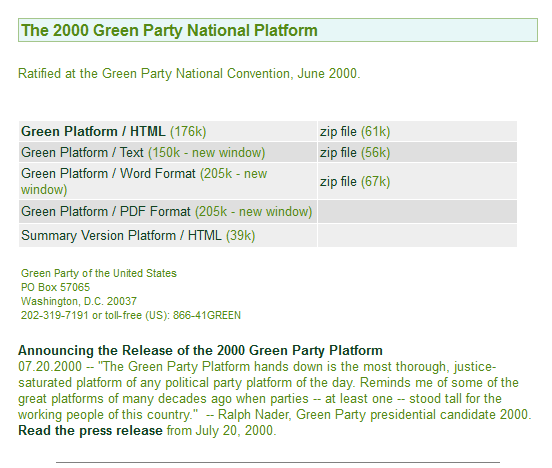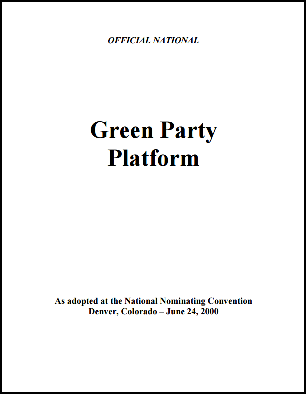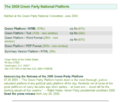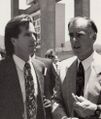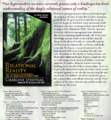Category:Green Platform
Founding US Green Party Platform - 2000
"The Green Platform hands down is the most thorough, justice-saturated platform of any political party platform of the day. Reminds me of some of the great platforms of many decades ago when parties -- at least one -- stood tall for the working people of this country." (Ralph Nader: July 2000 at the Green Party national convention)
"You must know that you were responsible for all this. All I did was accept.... Most of the issues and the subjects that the Green Party is adhering to are majoritarian positions in the United States of America and this is what commended the Green Party so much to those of us who were not in on the founding is that if you look very carefully at the Green Party platform, that's being proposed for your approval, this is by far the most comprehensive, broad-based platform that deals with the wide-range of systemic justice that's needed in this country. From the political to the corporate, to the cultural, to the civil liberties, civil rights, of any platform in the country." (August 1996 Green Party nomination acceptance speech)
• Green New Deal / Green Platform Update 2016
SJS / Siterunner: Looking back at the drafting of the US Green Party founding platform.
Let's talk just a bit about what goes into a political party platform...
The drafting of the Green Platform began after the 1992 Brown campaign platform, as Micah Sifry wrote about this transition. Your GreenPolicy siterunner chose to 'go independent' and build a "serious, credible, platform-based" Green Party, first in New Mexico and then, beginning with a formal "40 State Organizing Plan" presented to the annual Green parties gathering in 1995 at the University of New Mexico, to build a formal, legal national party.
Writing a NM Platform began in 1993 and it was the beginning of what became the national platform as it went through successive iterations, from the 1994 NM original platform, to the 1996 national platform informally approved at the 1996 Green Party convention to nominate Ralph Nader, and then to the formally approved "Official" national party founding platform approved at July 2000 nominating convention.
The challenge was to construct a successful model on which to build a growing, vital, U.S. Green Party. The model of party building came from an unlikely place: a small state in the hinterlands far from centers of power. In 1994 in Santa Fe, named after St. Francis of Assisi, the Catholic patron saint of the environment and animals, I began drafting and eventually the process led to feeling that I was being inspired by larger, perhaps spiritual forces. Green values became a foundation as I began, with the Santa Fe publisher Bear & Company book by Charlene Spretnak, "Spiritual Dimension of Green Politics" inspiring with Green Party values.
Political and policy ideas flowed from many sources and I deeply felt a diverse multi-colored tapestry of ideas that I shared as I wrote, from Great Books to green, visionary ideas. The first draft of a national platform for a new Green Party was ready to lift a first Green presidential campaign in 1996.
I'm recalling when Ralph Nader was first handed the draft platform as we requested he consider running as a new Green Party candidate for president. He would be the first and as the first, he would set a foundation in place.
The platform your GreenPolicy siterunner had worked up and given to Ralph Nader was received in a way that shocked me. His response was later shared as he accepted the Green Party nomination at UCLA in August 1996. He went on to say the Green Platform '96 was the reason he chose to run and in 2000 as the founding "official" 2000 platform was approved in Denver, as he watched before his nomination, he went on record that "The Green Party Platform hands down is the most thorough, justice-saturated platform of any political party platform of the day. Reminds me of some of the great platforms of many decades ago when parties -- at least one -- stood tall for the working people of this country." I had worked hard to pull together these platforms that expressed Green Party values and positions on the issues. A torch was being passed, going back years and decades to the the Great Books, to the modern green environmental movement, to the peace movement that led to the formation of the Green Party in the US and internationally.
Let me share a few thoughts about this time when ideas and a strategic plan became a reality, although delivering unexpected consequences in 2000, the opening up of a 21st century politics in a two-party dominated nation took another step forward.
After working with Jerry Brown closely on the platform for the 1992 presidential campaign, we had moved to extend a new vision of environmental security, peace and social justice on issues that took big steps in the 1960's and 70's. In my own political life, beginning with George E. Brown, peace work, environmental work, the first Earthrise photo and Earth Day, and continuing with many resources and inspirational relations, especially with Governor Jerry Brown and the 'We the People' platform of the 1992 presidential campaign, later with Senator Paul Wellstone and a cast of characters that extended my East LA roots to Manhattan and scholars like Hannah Arendt and Robert Heilbroner, and a journey across the globe, we reached out to form a new kind of international, global politics and political party. Now in over 100 countries we were on the way to changing politics of the past and setting forth new waves of rippling change.
The opportunity that was presented me in 1993 in Santa Fe, New Mexico, was to create what I began to call a "serious, credible, platform-based" third party. After the experience of the 1992 campaign, I became convinced a progressive and future-oriented politics was needed. The turn of the Democrats and Republicans away from the potential "peace dividend" with the ending of the Cold War as the Soviet Union collapsed, overextended from its decades of war spending, was a focus. Colleagues like Roger Morris and, at the president of St. John's University, Michael Riccards who asked me to advise him, further developed the ideas that carried over from the "Great Books" program of the NY New School and St Johns, as well as many years of security and environmental politics.
I chose to put forward a plan, a strategic plan, to build the party beginning with a New Mexico campaign in 1994, that was described later by Ballot Access News as one of the most successful independent party campaigns in four decades. This "serious, credible, platform-based" campaign (with a newly drafted NM Green Platform) became the model subsequently for a plan put forward to run a "40 State Green Organizing Effort". I wrote it and presented it to the NM Greens, then brought it to California Greens as a first step to achieve the goals of the plan which included a first-ever presidential campaign.
In 1995, the NM Greens held the national Green Party gathering at UNM and the "Great Kiva' and the 40 State plan was presented and supported, beginning a process that led to the 1996 Green presidential campaign. The drafting of a national platform began and I was faced with "process", a well-known word in the Green Party lexicon. Often, too often, this political process had gone in counterproductive directions and it was clear that better process was needed if the new national platform was to be both democratic in its process and successful. I put forward an online process, utilizing the newly enabled web connectivity between state Green parties and individuals. The NM Green plan chose to workaround the previous blocking of Green members who has coopted the Green Party previously. I called the new interactive process "3-Ds": discussion, debate and decision-making... The larger goal was to have serious, well-developed policy positions and to turn Green policies/positions into reality.
My personal goal of "serious, credible, platform-based" Green Party became what was sometimes called your siterunner's "mantra." Although the U.S. Green Party had many factions, and many individual Greens did not support what at times were referred to as reform politics of 'to turn Green policies/positions, into reality', the Green Party began to have serious impact.
At this time, apart from Green platform writing and organizing, I was appointed and confirmed by the New Mexico state legislature to join the State Board of Education. As a state official I began to oversee K-12 public education, which included over 50% of the state's budget. One of my key tasks was to expedite and facilitate web development and policies for all the schools and districts in the state. Also as chair of NM Technology Council and member of an interstate working group, we established the first 'virtual university', that today is the largest in the country. The web was booming and networking was in the sails and we were moving fast. Science standards were improved and a new more equitable education funding formula was adopted by the legislature after three years of local meetings and lobbying.
Continuing with Green organizing work, I developed an effective website, gp.org, to advance the new Green Party process. I obtained and registered gp.org and built a website to reach out and interactively engage with Greens across the country, using the NM Green Party platform as a beginning point and then expanding the structure and positions/policies into national and international reach.
From 1995 to 2000, your GreenPolicy siterunner guided a "3-D process" and drafted an initial Green Platform. The 2000 "official" founding platform of a new national FEC-legalized Green Party was approved at the 2000 national convention at the Renaissance Center in Denver by some 2000 delegates from around the country.
○
The "3-Ds" -- discussion, debate and decision-making -- of the strategic plan had led to a "serious and credible" Green foundation platform and national party.
○ ○ ○ ○ ○ ○ ○ ○
Green Key Values
"Values-based Politics"
- • https://www.greenpolicy360.net/mw/images/Green_Key_Values_Spiritual_Dimensions-Spretnak-1.pdf
- • https://www.greenpolicy360.net/mw/images/Green_Key_Values_Spiritual_Dimensions-Spretnak-2.pdf
- • https://www.greenpolicy360.net/mw/images/Green_Key_Values_Spiritual_Dimensions-Spretnak-3.pdf
The question-format key values statement led us to our ten declarative-format KVs in the 1996 presidential campaign and founding Green Party 2000 Platform
- • http://gpus.org/committees/platform/2000-platform/#values
- • https://www.greenpolicy360.net/w/File:Call_to_Action,_Preamble,_and_Ten_Key_Values_US_Green_Party_Founding_Platform_2000.pdf
- • https://www.greenpolicy360.net/mw/images/Call_to_Action%2C_Preamble%2C_and_Ten_Key_Values_US_Green_Party_Founding_Platform_2000.pdf
○ ○ ○ ○ ○
August 2016
In 2016, during the Jill Stein campaign, a radical change in direction was put forward. The economic diversity, economic justice positions in the Green Platform were replaced by an ideological group of advocates numbering about one hundred.
The Green Party US website claims approx. 250,000 green party registered greens in states across the country.
The replacement of the economic positions of the US Green Party was thus decided in an 'amendment' to the founding Green Party Platform by approx. 100 of 250,000 Green registered members. Questions were immediately raised about the democratic extent of this vote to re-make the basic beliefs and values of the US Green Party. However, the cadre that pushed the profound change prevailed. The amendment noted that 'expropriation' of property was not immediately being called for. After years of work, outreach and discussion, debate and decisions from 1994 through to the founding platform in 2000, the Green Platform was set aside by a small ggroup vote. One hundred or so Greens voted to change the core positions, the foundation of the US Green Party in August 2016 from economic diversity and emphasis on economic justice in the 'real world' to another world view. This other world view is that of a faction as the Green Party finds its name coopted.
Economics of diversity, though widely supported, was rejected and replaced with a professed "Ideology" of "anti-capitalism" and "eco-socialism" (although these terms were not debated in the amendment to change the Green Platform.)
Online and in Wikipedia, unnamed persons began in 2017 to re-label the U.S. Green Party's "Ideology" as:
Anti-capitalism 2
Eco-socialism 3
The convoluted history of the US Green Party, at this point, began to shift back to the former structure of what was known as tG/GPUSA prior to the group's demise in the 1990s.
Although the 2016 restructuring vote was challenged by many experienced Green Party members, the restructe amendment passed by about a hundred in the heat of the Stein campaign against Hillary Clinton and support among some for a Donald Trump option.
In 2018, one of the long-time players in the group that worked to restructure the national Green Party announced plans to run for the Green Party nomination for president.
○
International Green Parties and the Green Party of the United States
The Founding US Green Platform and First Presidential Campaign, by Steven Schmidt
– Presented to the German Historical Institute / Boll Institute Conference in Washington DC / “The Origins of Green Parties in Global Perspective” / May 26, 2004
Article available @
- ○
US Green Party National Platform - Official National Platform
Approved in 2000 at the National Green Party Convention / Denver, CO
○
A Historic Moment
- The US Green Party Becomes "Officially" a National Committee/Party
- The US Green Party Platform and Key Values
- The 2000 Green Party founding platform document in the 2001 Federal Election Commission Request Petition and Advisory Opinion
Federal Election Commission
FEC approves legal status of Green National Committee/Party, Nov. 2001
Founding Platform of the Green Party of the U.S. / Filed with the FEC
• http://gpus.org/committees/platform-committee/2000-platform/
○
As I look back at the drafting of the U.S. Green Party's Key Values adopted formally as I presented them to the 2000 national Green Party Convention in Denver, along with the founding Green Party national platform, it remains for future greens, whether formally affiliated with the Green Party in the US or greens who share core values of Green parties to do their best in bringing the values and positions of green thought into reality.
The politics of the present era clearly demand the independent, future-oriented vision of green, environmentally focused 'planet citizens'...
-- SJS March 2015
○
Subcategories
This category has the following 3 subcategories, out of 3 total.
E
G
Pages in category "Green Platform"
The following 15 pages are in this category, out of 15 total.
D
Media in category "Green Platform"
The following 62 files are in this category, out of 62 total.
- 2000GreenPartyPlatform.pdf ; 318 KB
- All species day with homo sapien in Santa Fe .jpg 640 × 369; 98 KB
- AOC March 26, 2019.jpg 597 × 433; 58 KB
- Caroline Lucas-Green New Deal.jpg 584 × 391; 71 KB
- Climate Time Machine NASA Earth Science-2.png 714 × 210; 210 KB
- Congressman george.e.brown.gif 235 × 305; 41 KB
- Earth Summit 1992-s.png 336 × 418; 283 KB
- Earth Summit 1992.jpg 600 × 746; 171 KB
- Eco-feminism-nature.png 365 × 365; 84 KB
- Eco-Nomics.png 262 × 90; 8 KB
- Energy - Electric Measuring and Monitoring.png 715 × 1,978; 862 KB
- European Greens - Baerbock - Candidate for German Chancellorship.jpg 513 × 185; 37 KB
- European Greens EGPCongress Dec 2022.png 800 × 745; 640 KB
- From 1968 to 1992 -- and the Journey continues....png 572 × 851; 320 KB
- George Brown 1969-Reflections on US Role in the World.png 700 × 372; 99 KB
- German foreign minister travels to India.png 640 × 178; 115 KB
- GH1 sm.jpg 289 × 84; 10 KB
- Green New Deal - Bloomberg Jan 29,2019.png 640 × 757; 589 KB
- Green New Deal - Resolution.pdf ; 55 KB
- Green Parties - International Listing Nov2013 .jpg 454 × 63; 9 KB
- Green Party Platform US founding docs.png 552 × 468; 35 KB
- Green Party US Early History 1984-2001.png 925 × 997; 294 KB
- Green times.jpg 352 × 262; 21 KB
- Greeneuropeanjournal.eu.jpg 485 × 237; 30 KB
- GreenPartyPlatform 2000 KV10.png 338 × 531; 25 KB
- GreenPartyplatform cover of founding-platdoc-2000 s.png 306 × 394; 10 KB
- GreenPartyPlatform drafting in Santa Fe 1996 .png 768 × 840; 368 KB
- Grn Parties international list cover-2014.png 771 × 819; 589 KB
- Jerry Brown 92 Presidential Platform We the People.jpg 448 × 586; 40 KB
- Jerry w Steve '92 pres campaign at the Dem plat hearing m.jpg 416 × 492; 44 KB
- John Rensenbrink - Green Horizon Magazine - Fall 2022.png 480 × 631; 569 KB
- Methods of Nonviolent Action.pdf ; 49 KB
- Neither left nor right, but in front.png 669 × 844; 359 KB
- Over the Pacific.png 800 × 441; 617 KB
- Relational Reality by Charlene Spretnak.png 772 × 836; 814 KB
- Relational Reality.jpg 267 × 400; 53 KB
- SJS 1994 NM Green Lt Gov campaign.jpg 278 × 414; 15 KB
- StatueofLiberty StrategicDemands.jpg 800 × 241; 11 KB
- Steven J Schmidt, May 2023.png 363 × 484; 383 KB
- The Spiritual Dimension of Green Politics.jpg 222 × 346; 20 KB
- We Want You Security State investigation WaPo.png 612 × 480; 645 KB
- When we started up the Green Party US.png 536 × 708; 191 KB
- Your vote.png 318 × 133; 11 KB
